Shiitake Dashi is a great option for vegans and vegetarians to use for Japanese soup stock. When you soak dried shiitake mushrooms for recipes, simply collect the liquid and repurpose it as an intense stock that’s packed with umami.
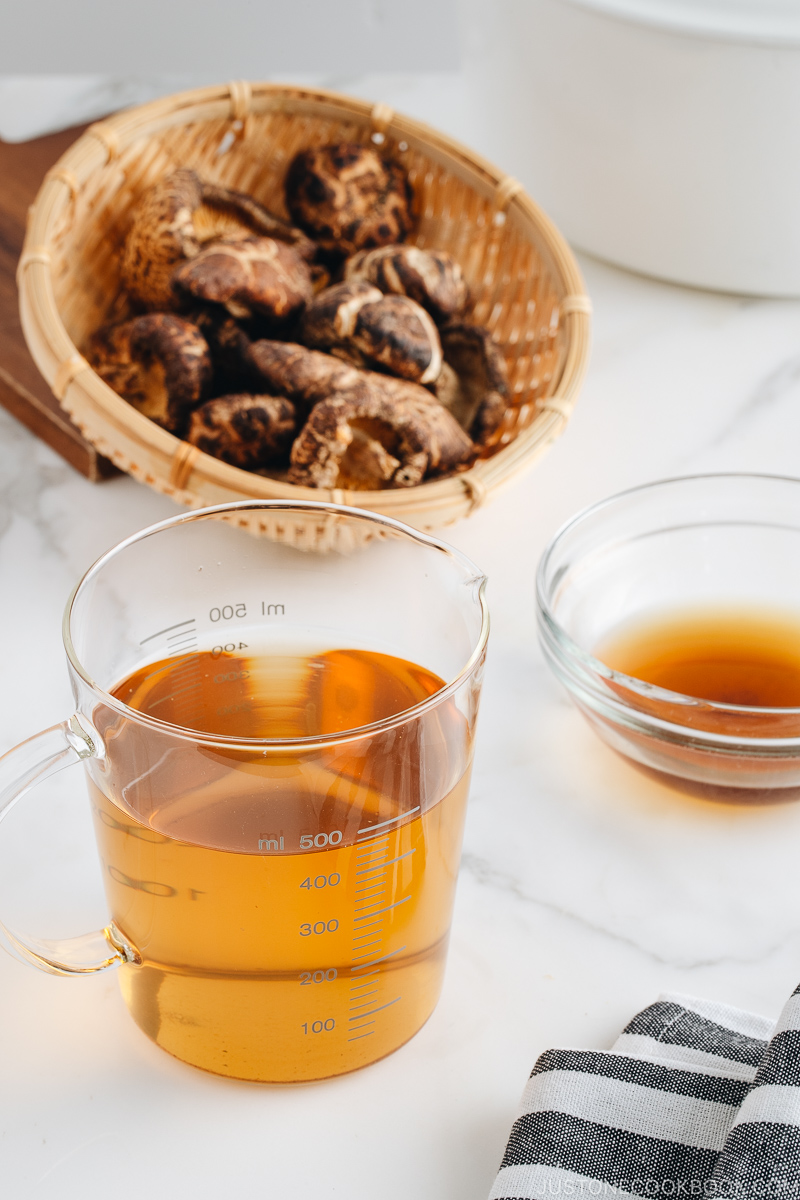
Dashi is Japanese soup stock that’s a fundamental ingredient in Japanese cuisine to create umami. Japanese stocks are often made with fish like dried bonito flakes or iriko/niboshi (dried anchovies). However, there are plant-based options that you can use, too.
Today, I want to share how to make Shiitake Dashi (干し椎茸の戻し汁/椎茸のだし) for use in vegan/vegetarian recipes. I will show you how to rehydrate dried shiitake mushrooms for other recipes and repurpose the soaking liquid as a soup stock for cooking.
Table of Contents
What is Shiitake Dashi?
Shiitake Dashi (干し椎茸の戻し汁/椎茸のだし) is the liquid created from rehydrating dried shiitake mushrooms in water.
Instead of regular vegetable broth, we use Kombu Dashi and Shiitake Dashi as the only vegetarian and vegan stock in Japanese cooking. These soup stocks allow you to cook authentic Japanese dishes without sacrificing flavor.
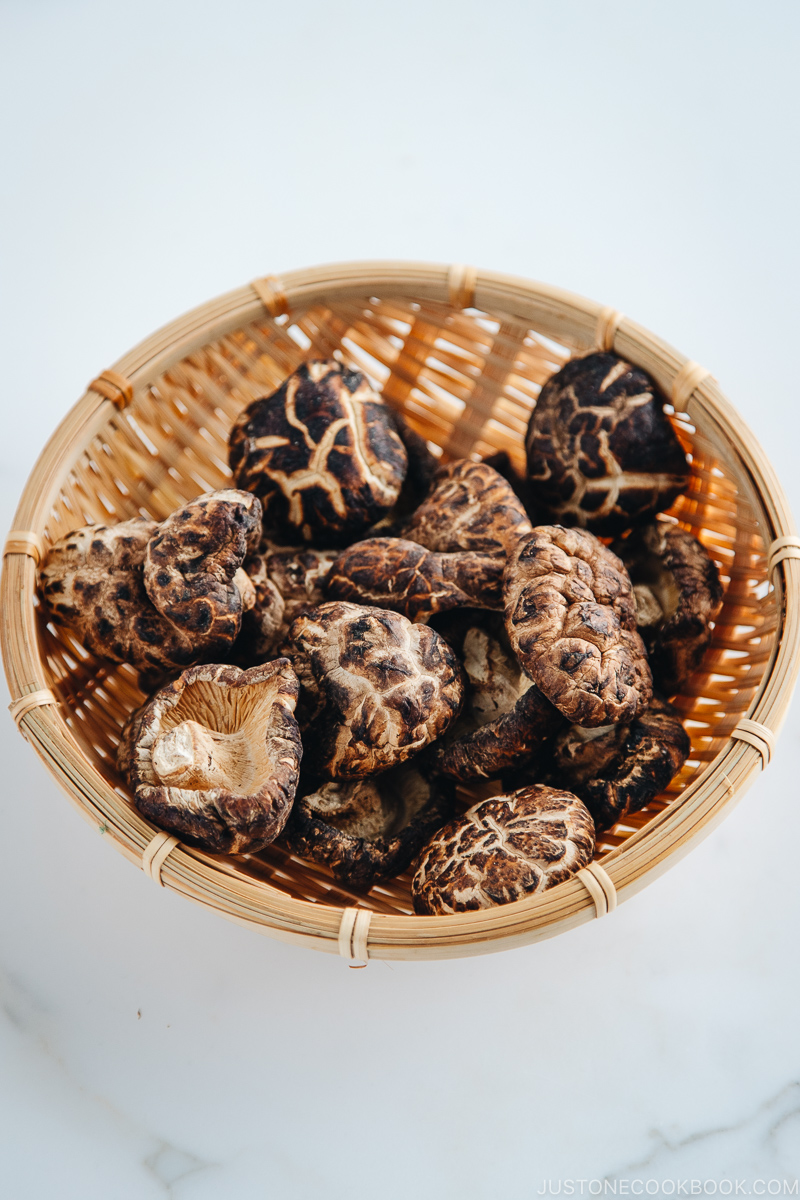
For Vegetarians and Vegans
Shiitake Dashi is considered a by-product of reconstituting dried shiitake mushrooms. We use only a small amount of water for rehydrating, so the resulting stock has a very strong and concentrated flavor.
Since the soaking liquid has good nutrients and flavor, we never throw it away and try to find a use for it in cooking. We usually combine the liquid with other kinds of dashi to enhance flavor and add umami. However, we rarely used shiitake dashi on its own.
Since I moved to the US, I learned that a lot of vegetarians and vegans here use diluted shiitake dashi (the soaking liquid) as a vegetarian/vegan-friendly stock in their Japanese cooking.
Intense and Strong Shiitake Flavor
In Japan, kombu dashi is by far the most commonly used dashi for vegetarian/vegan cooking. That’s because shiitake dashi’s intense flavor often overwhelms subtle Japanese seasonings.
However, if you enjoy the deep and rich taste of shiitake dashi, you can use this soaking liquid exclusively for stock to cook Japanese food.
Please note that we can only use dried shiitake mushrooms to make stock because fresh shiitake mushrooms lack the same intense flavor profile.
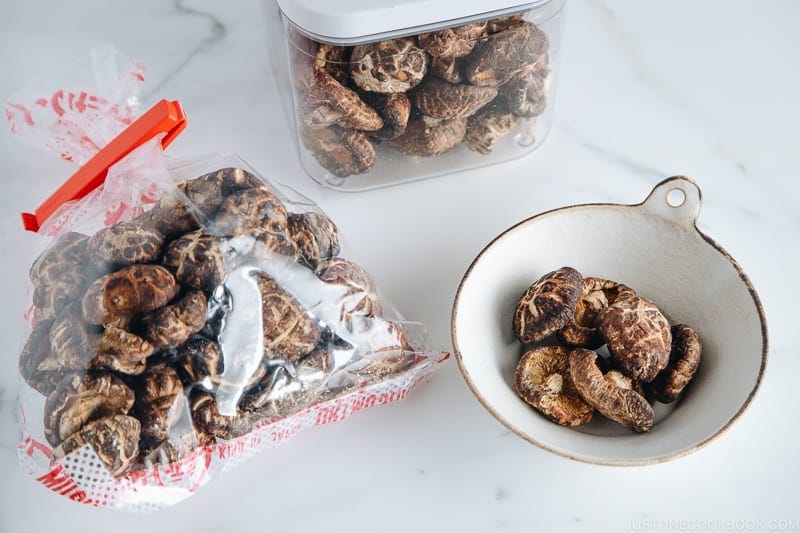
How to Get the Best Flavors from Dried Shiitake Mushrooms
Good dried shiitake mushrooms are expensive, but the flavors and texture are amazing. Oita Prefecture (大分県) in the Kyushu region is known for the best-quality dried shiitake mushrooms. Follow these tips to extract the best flavor from this precious ingredient:
- Buy thick mushrooms with deep white fissures on the cap (more flavor).
- Use cold water to soak dried shiitake mushrooms to slowly bring out the flavor from the mushrooms, preferably overnight.
How To Make Shiitake Dashi
In this recipe, I‘ll show you how to make two types of shiitake dashi: a typical concentrated stock and a diluted stock. I include both the typical method (a few hours or overnight) and the quick method (15 minutes).
Concentrated Stock (Typical Method)
- Soak 3 dried shiitake mushrooms in ½–⅔ cup cold water in an airtight container. Place a heavy object on top to submerge the shiitake. Steep in the refrigerator for a few hours or preferably overnight until soft.
- Optional quick method: Soak the shiitake in ½–⅔ cup warm water (body temperature) for 15 minutes or until softened.
- Squeeze to drain the mushrooms. Reserve the soaking liquid. Use the rehydrated shiitake in another recipe. Cut off the tough stems and use them as you would fresh shiitake mushrooms.
- To collect the dashi, strain the soaking liquid through a fine-mesh sieve. Your concentrated stock is now ready to use.
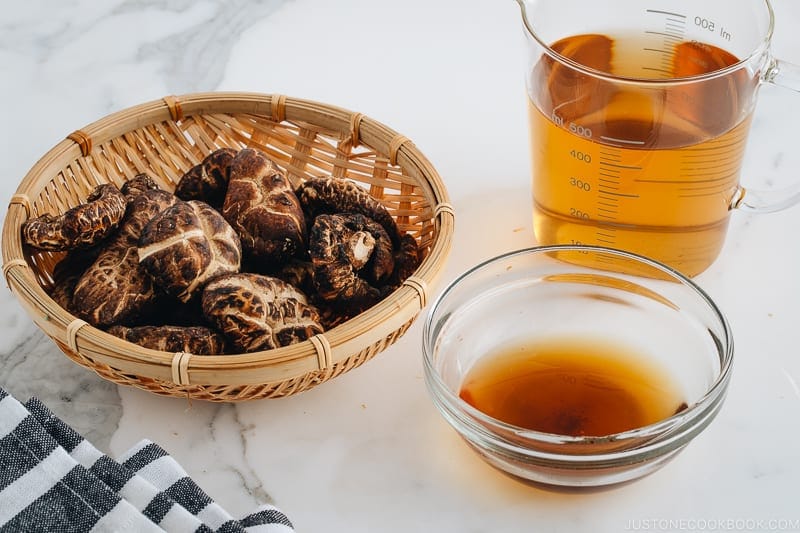
Diluted Stock
- Soak 3 dried shiitake mushrooms in 2 cups cold water in an airtight container. Place a heavy object on top to submerge the shiitake. Steep in the refrigerator for a few hours or preferably overnight until soft.
- Optional quick method: Soak the shiitake in 2 cups warm water (body temperature) for 15 minutes or until softened.
- Squeeze to drain and reserve the liquid.
- Strain the liquid to collect the dashi. Your diluted stock is now ready to use.
Japanese Soup Stock for Vegetarian Cooking
Shiitake dashi stores well in the refrigerator for 2–3 days and up to 1 month in the freezer, so you can prepare your stock ahead of time. That way, you’ll always have dashi on hand whenever you make miso soup or noodle soups.
Try these vegetarian and vegan-friendly recipes that use dashi:
- Vegetarian Ramen
- Vegan Miso Soup
- Spinach Ohitashi (Japanese Spinach Salad)
- Kenchinjiru (clear soup with root vegetables and tofu)
- Kitsune Udon
The Ultimate Dashi Guide
Dashi plays an important role as a flavor enhancer in Japanese cooking, so you don’t need to season the food with too much salt, fat, and sugar. Rich in minerals and other vitamins, dashi is considered a healthy ingredient in our daily diet.
There are six different types of dashi you can use in Japanese cooking, including vegetarian and vegan dashi (*).
- Awase Dashi – a stock made from a combination of dried kelp + bonito flakes
- Kombu Dashi * – a stock made from dried kelp
- Katsuo Dashi – a stock made from dried bonito flakes
- Iriko Dashi – a stock made from dried anchovies/sardines
- Shiitake Dashi * – a stock made from dried shiitake mushrooms
- Vegan Dashi * – a stock made from dried shiitake mushrooms and kombu
If you are new to different types of dashi, check out my Ultimate Dashi Guide.
Wish to learn more about Japanese cooking? Sign up for our free newsletter to receive cooking tips & recipe updates! And stay in touch with me on Facebook, Pinterest, YouTube, and Instagram.
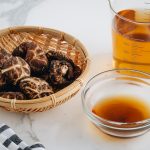
Shiitake Dashi
Video
Ingredients
For Rehydrating the Dried Shiitake and Collecting the Dashi
- 3 dried shiitake mushrooms (5–10 g each; found in Japanese and Asian grocery stores)
- ½–⅔ cup water (enough to cover the mushrooms)
For a Diluted Dashi
- 3 dried shiitake mushrooms (5–10 g each)
- 2 cups water
Instructions
Before You Start…
- In Japan, we collect shiitake dashi as a by-product of reconstituting dried shiitake mushrooms for recipes. We soak them only in just enough water to cover, so the resulting stock has a very strong and concentrated flavor. In this recipe, I‘ll show you two ways to rehydrate dried shiitake for either a typical stock or a diluted stock. Ideally, you want to start your dashi ahead of time and let it steep for a few hours or preferably overnight. Alternatively, I‘ll also show you a quick method that takes only 15 minutes of steeping time.
★ To Rehydrate the Dried Shiitake and Collect the Dashi ★
- Gather all the ingredients. Check the dried shiitake mushrooms to see if there is any dust or dirt trapped in the gills. If there is, use a pastry brush to clean it. Do not wash it under water.
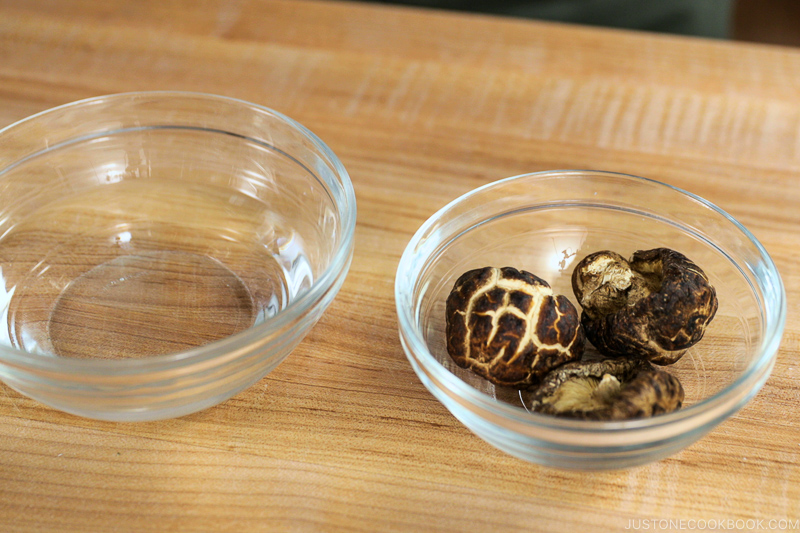
- Place 3 dried shiitake mushrooms in a mason jar or airtight container and add ½–⅔ cup water (cold) to cover the mushrooms. Place a heavy object on top of the mushrooms to keep them submerged so they fully rehydrated. If you have time, let them soak in the refrigerator for a few hours or preferably overnight. If you are in a hurry, soak them in ½–⅔ cup warm water (body temperature) for 15 minutes or until softened.
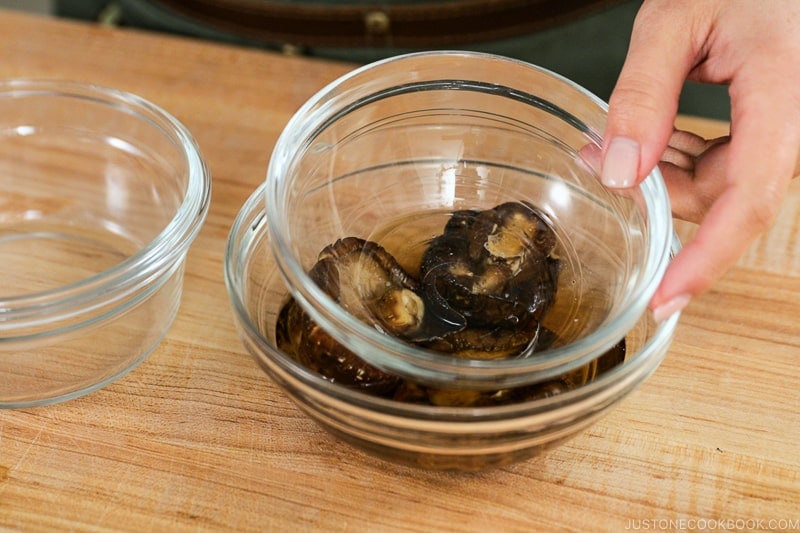
- When the shiitake mushrooms are tender, squeeze to drain, reserving the liquid.
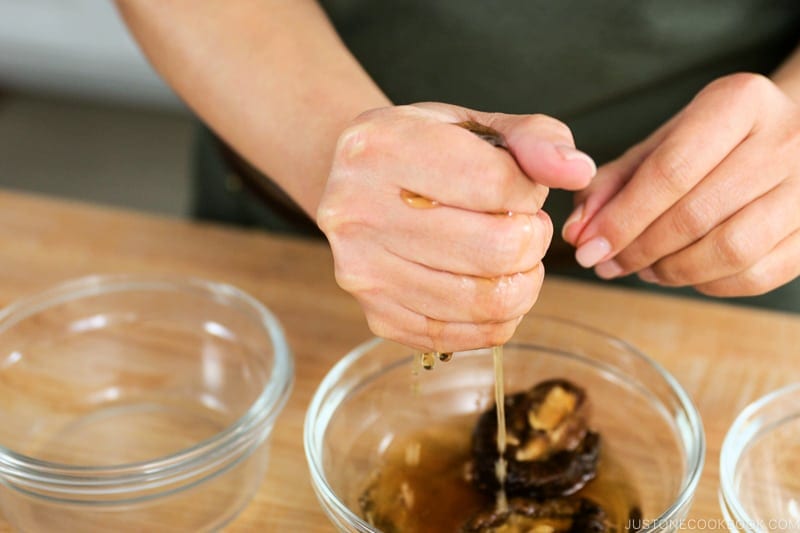
- Use the rehydrated shiitake mushrooms in the recipe of your choice. You can use them as you would fresh shiitake mushrooms. Simply remove and discard the tough stems with a knife.
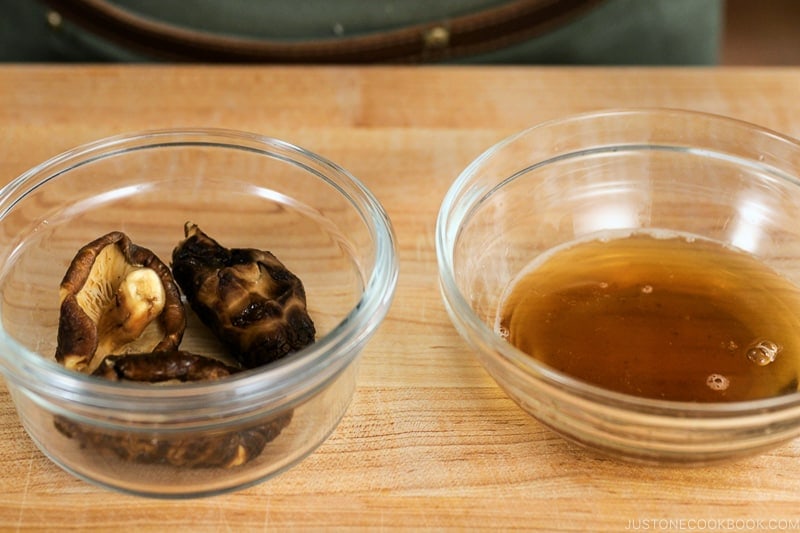
- To collect the shiitake dashi, run the soaking liquid through a fine-mesh sieve to catch any dirt or debris. This concentrated Shiitake Dashi is now ready to use for adding to a sauce, steaming, seasoning, and so on.
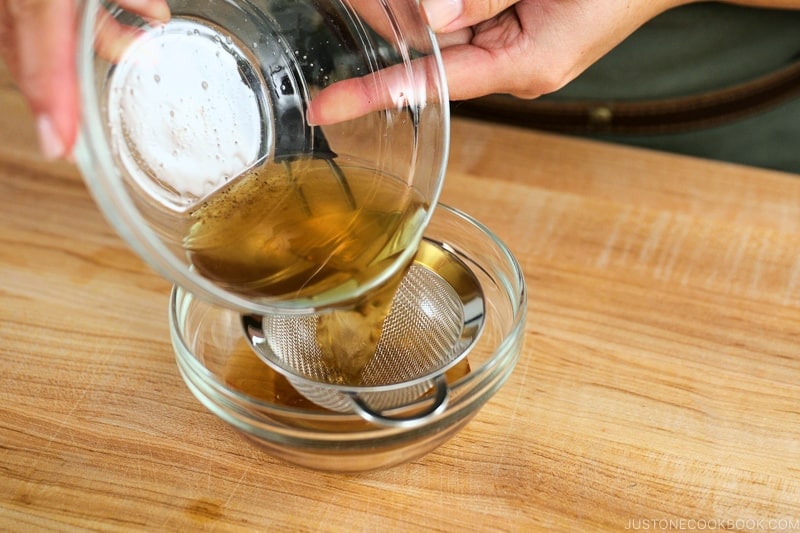
To Store
- You can store the dashi in the refrigerator for 2–3 days or in the freezer for 1 month.
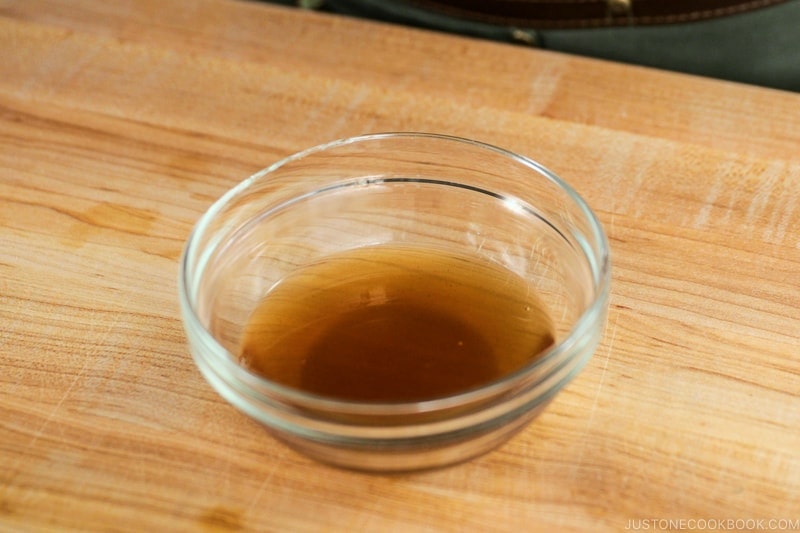
★ To Make a Diluted Shiitake Dashi ★
- Gather all the ingredients. Check if there is any dust or dirt trapped in the gills of the mushrooms. If there is, use a pastry brush to clean. Do not wash it under water.
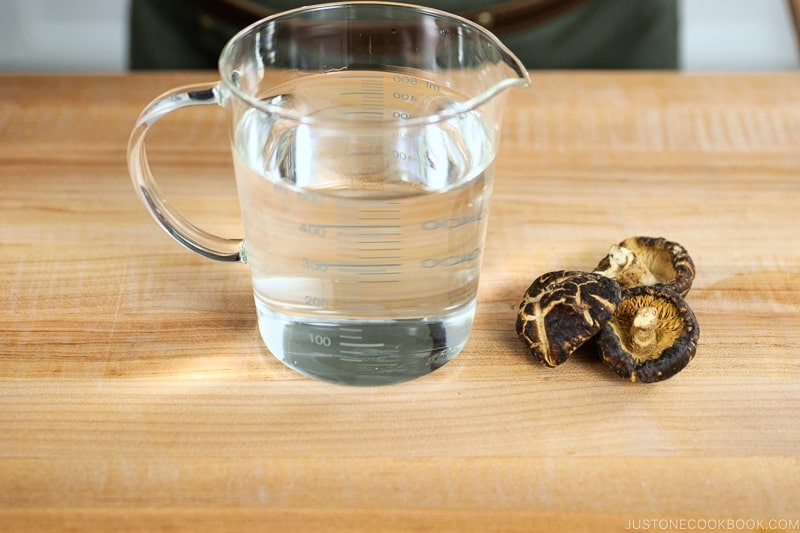
- Soak 3 dried shiitake mushrooms in 2 cups water. Place a heavy object on top of the mushrooms to keep them submerged so they fully rehydrated. If you have time, let them soak in the refrigerator for a few hours or preferably overnight. If you’re in a hurry, soak them in 2 cups warm water for 15 minutes or until softened.
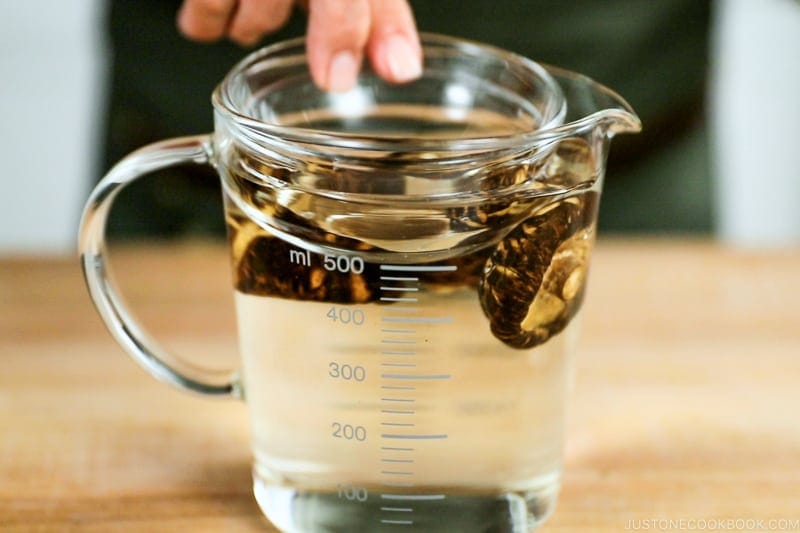
- After soaking for several hours…
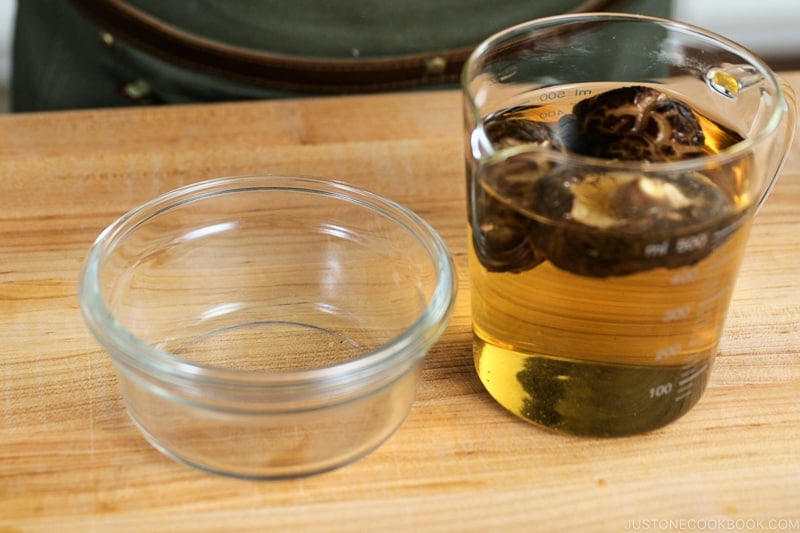
- When the shiitake mushrooms are tender, squeeze to drain, reserving the liquid.
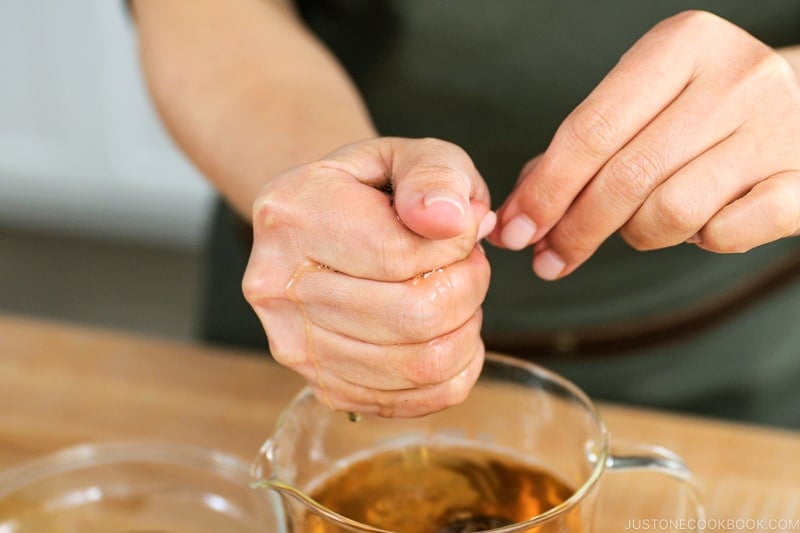
- Use the rehydrated shiitake mushrooms in the recipe of your choice. You can use them as you would fresh shiitake mushrooms. Simply remove and discard the tough stems with a knife.
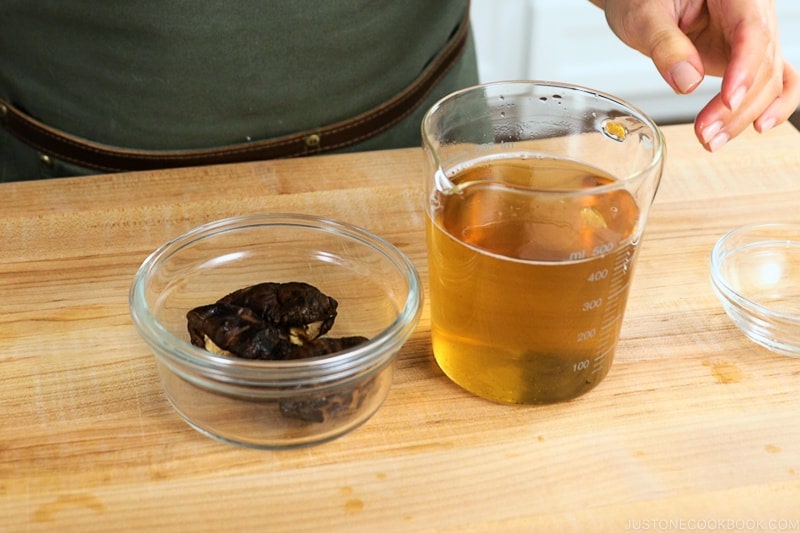
- To collect the shiitake dashi, run the soaking liquid through a fine-mesh sieve. Your diluted Shiitake Dashi is now ready to use.
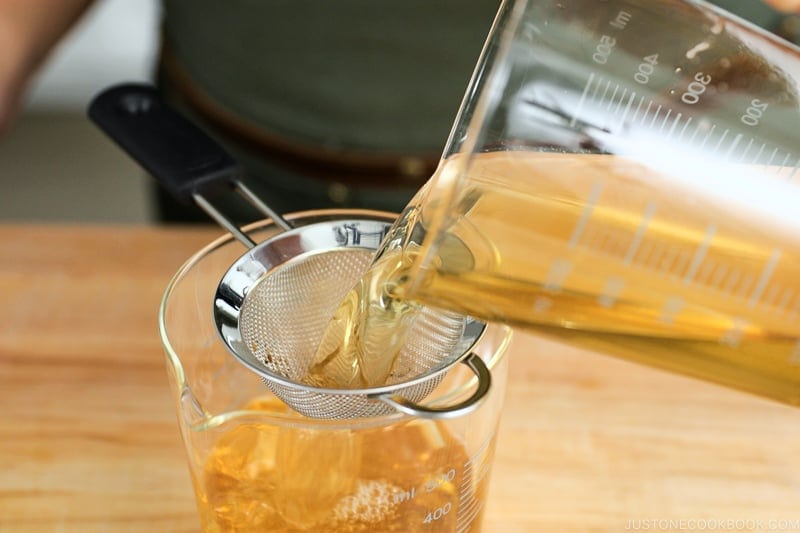
To Store
- You can store the dashi in the refrigerator for 2–3 days or in the freezer for 1 month.
Notes
Nutrition
Editor’s Note: This post was originally published in March 2015. The images and recipe have been updated in April 2019.
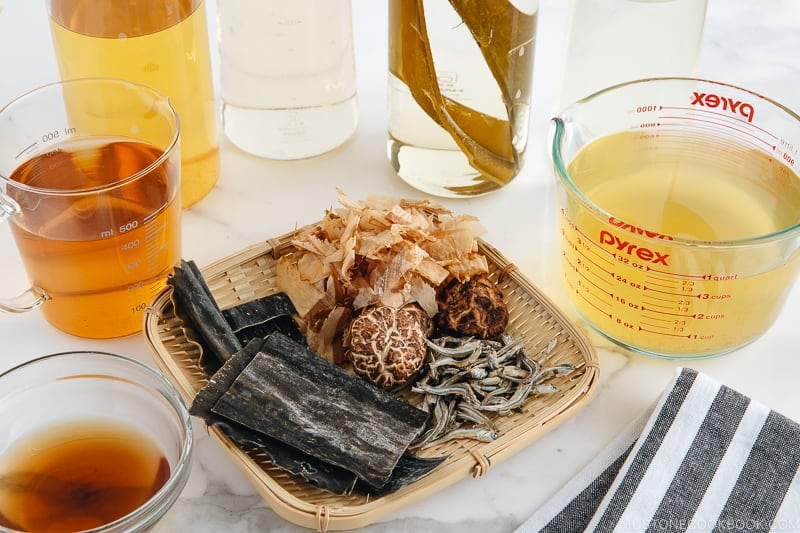
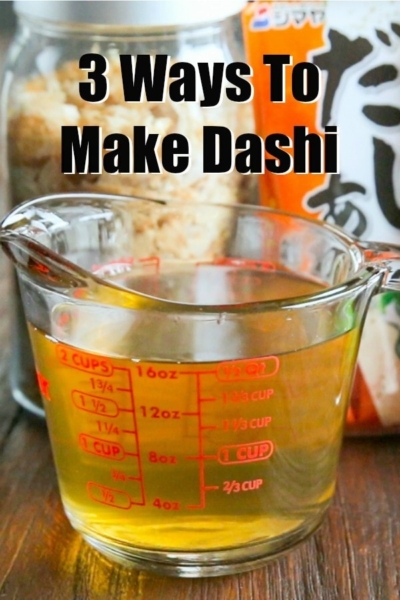
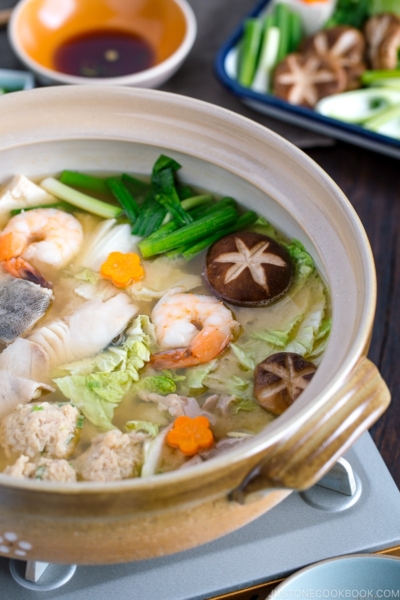
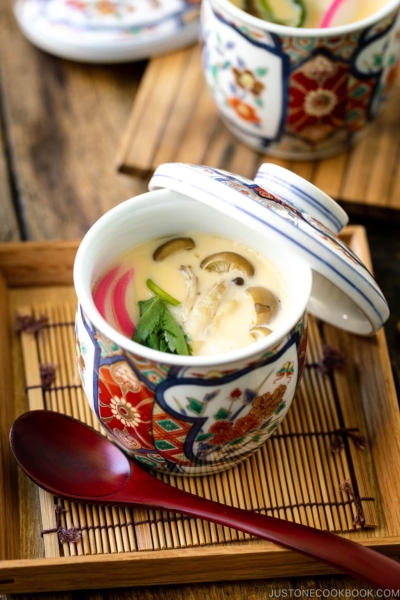
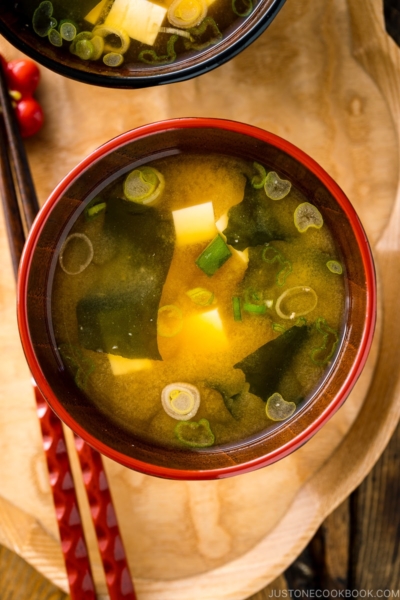




This was my lunch yesterday, thanks for another tasty meal
Hello, Trish! Thank you for reading Nami’s post and trying her recipe!
Its been a relaxing weekend trying new recipes of foods I like. Living on remote island, its not easy to get things. So making them is best. thank you for showing me how..
Hi, Ray! We’re delighted Nami’s instructions were helpful.
Thank you for trying Nami’s recipe. Happy cooking! 🤗
Dear Nami,
at least after a lot of years cooking japanese I buyed dried shiitakes. The vegan Dashi with Shiitake and kelp (I always eat the bonito/kelp dashi, but am our of bonito) reminded me of that strange taste cup ramen always got, now I know it’s made from or after shiitake. Today I used the mushrooms itself and as I didn’t squeeze them I just did that in my creamsauce and it was such a booster of umami! Wow! This was really really tasty, I wished I had cutted the mushrooms smaller to eat more spoonful of them. Now I know what people mean with the umami of shiitake.
The next batch Dashi is in the fridge … can’t wait ….
Thank you a lot, like always for this recipe.
Hello, Anna. Thank you very much for sharing your experience with us.
We’re glad to hear you discovered Umami in the Shiitake! 🥰
I do not understand why there are two recipes for this item. Are they separate Dashi?
Hi Joe! In Japan, we do not generally make standalone “Shiitake Dashi” like what I provided here. It’s not very common, because the flavor is too strong for classic Japanese dishes.
However, we do use the leftover liquid from rehydrating shiitake mushrooms. We often call this liquid “Shiitake no modoshi-jiru,” and use it to flavor some savory dishes. This is the standard usage with the remaining liquid after rehydrating. It’s considered wasteful to throw it away, so we utilize it, but the main ingredient is the hydrated shiitake.
Since the “shiitake dashi” seems like a popular dashi for vegans, I included it here.
Hope this helps! If I was vegan and trying to make dashi, I’d use Vegan Dashi, instead of standalone shiitake dashi.
https://www.justonecookbook.com/vegan-shiitake-kombu-dashi/
Thanks! I’ve used this method to make Dashi for miso soup before, but do you know if I can boil this Dashi to concentrate it? I want to make mushroom gravy with as much concentrated flavor as I can, and this seems like it might be a good place to start.
Hi Celeste, Thank you for reading Nami’s post and trying her recipe!
Instead of boiling it down, we recommend increasing the Shiitake amount to give the dashi a stronger flavor.
We hope this was useful!
Can you make a second dashi with the same mushrooms like you can with kombu? How long do rehydrated shiitake keep in the fridge?
Happy New Year!
Thank you so much for this Making a dashi from dried shitake mushroom.
I really love your notes of recipe. There is always an alternative recipe for some needed ingredients, no need to always buy in the store.And this is so helpful.
My kids and I love Japanese Food.
Your recipe and its procedure is so friendly. With your Justonecookbook we tend to enjoy Japanese food especially we are in this pandemic that we cannot bring kids outside. Your email is so great and very useful.
Arigato Gozaimasu
Hi Dolores, Thank you very much for trying many of Nami’s recipes and for your kind feedback. Your kind words meant so much to us!💕 Thank you for your love and support!
I plan on soaking the mushrooms overnight in the fridge. Can I also soak a piece of kombu with the mushrooms?
Hi Kimberly,
Yes. You can soak both together.
Enjoy!
Hi Nami,
Thank you for showing us how to make dashi. You really introduced me to Japanese cooking and baking. Before I found you, i have always put shiitake mushrooms, dried kelps, and bonito flakes altogether in the pot. Is that ok?
Yesterday, i made awase dashi and shiitake dashi. Is it ok to leave them overnight at room temperature? Will it be ok to combine 2 dashi together to make soup? Thanks
Hi Catherine! In Japan, We don’t usually use dried shiitake mushrooms when we combine with kombu and katsuobushi because the mushroom dashi is so strong. But if that’s what you prefer, you can. It’s a bit of waste if you are using good quality kombu and katsuobushi as mushrooms flavor can be overpowering too much. I am not sure where you live, but for safety, I recommend keeping in the fridge. Water could go bad at room temperature when it’s a warm environment. 🙂
Your website is my best site for Japanese recipes. Most ingredients are connected and you give great info. You guys have a good teamwork from you two & your tech group. 👏🏻👏🏻👏🏻
Hi Sonny! Thank you so much for your kind and encouraging words!